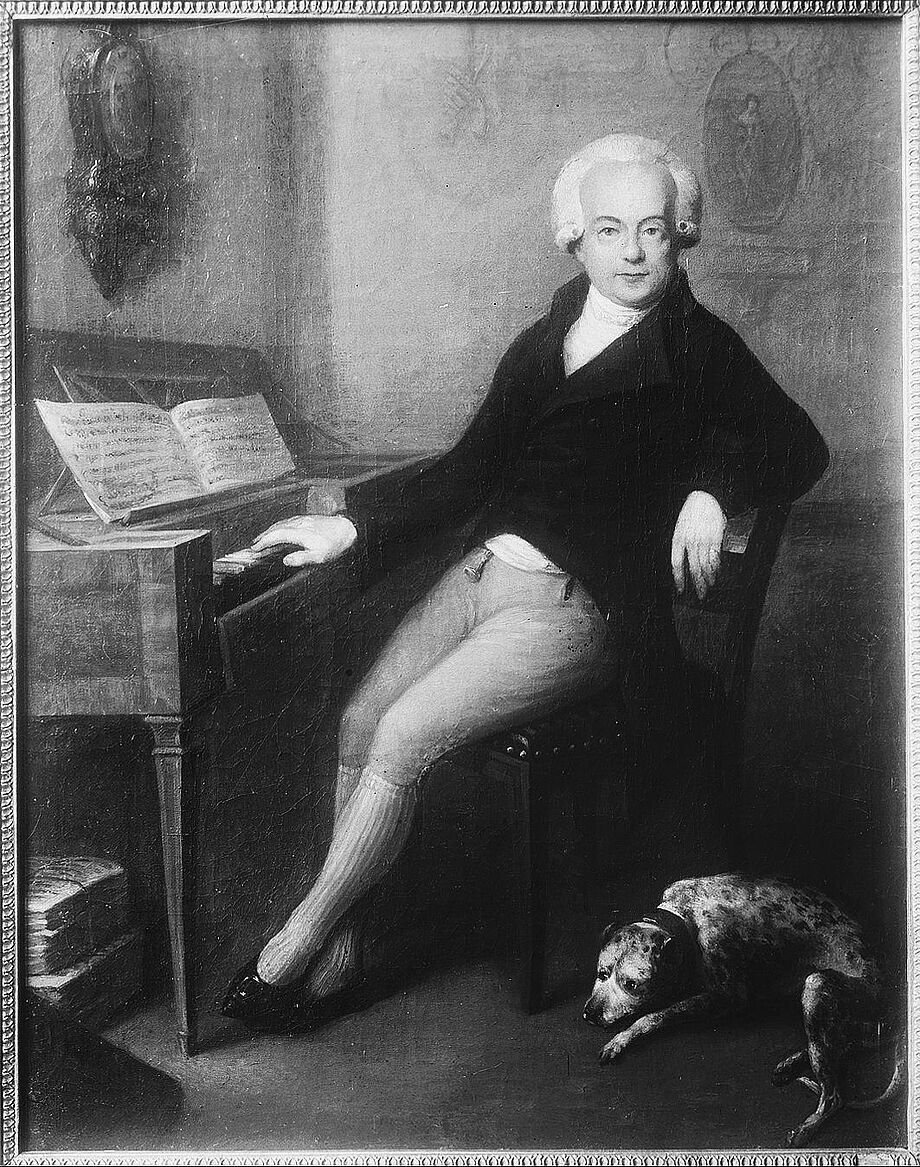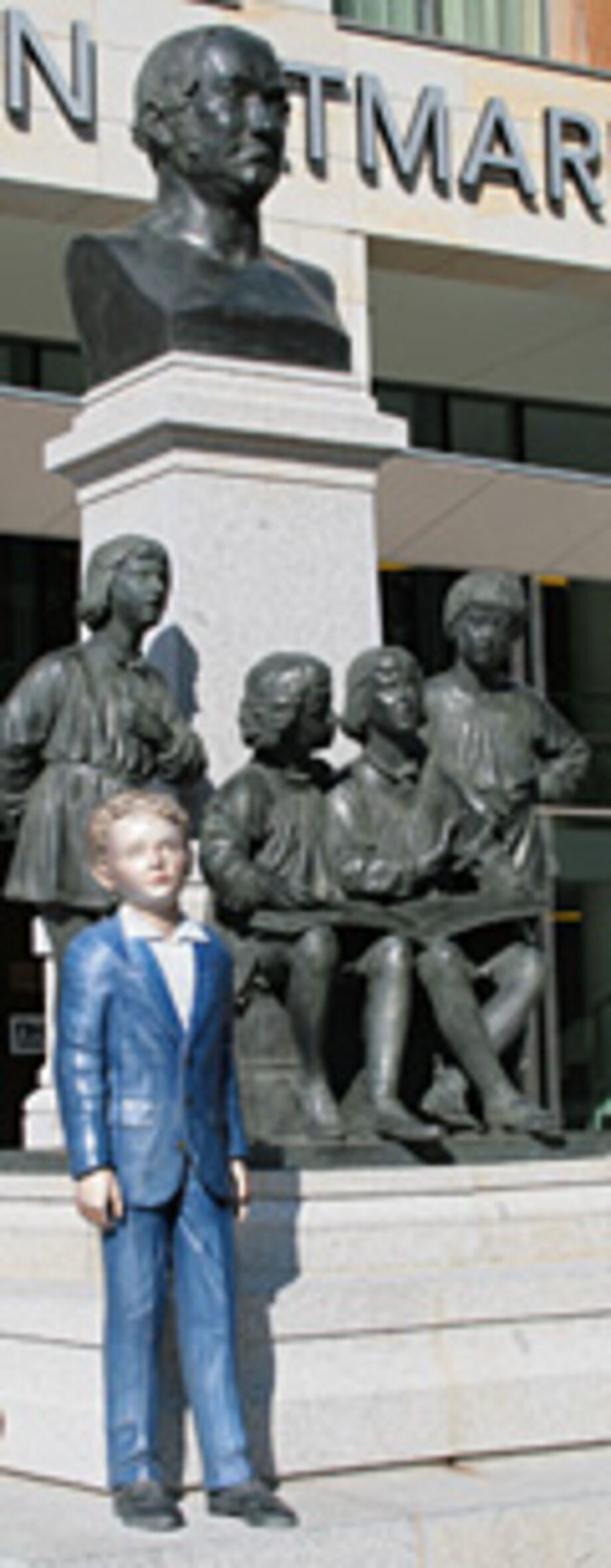Music Department: Spotlights
Spotlights
New acquisitions, anniversaries, research findings: there are always opportunities to spotlight individual topics, activities or objects of the Music Department. In the following, you will find a small selection of noteworthy aspects from the broad spectrum and rich holdings and activities of the Music Department.
Richard Wagner Jubilee 2013

The opening bars of Das Liebesmahl der Apostel
Richard Wagner borrowed literature from the Royal Library in Dresden – according to Egon Voss in his most recently published Wagner book. It’s possible that this helped the composer to find inspiration for new operas, such as Die Meistersinger von Bayreuth, in which Hans Sachs sings at the end: Verachtet mir die Meister nicht und ehrt mir ihre Kunst! (Do not disdain our Masters thus, But honour well their Art!).
On the occasion of the 200th anniversary of the birth the SLUB is presenting historical documents of Richard Wagner: the autograph score for Das Liebesmahl der Apostel (premiered in the Frauenkirche Dresden in 1843); other autograph scores, such as the festive song Der Tag erscheint, der ihn uns wiedergab and the Lied der Hirten from Tannhäuser, as well as original letters; program notes and artist postcards from premieres of Wagner’s works in Dresden; orchestral instrumentation of various opera performances under the direction of Richard Wagner; shellac discs; opera libretti; the police report from 1851, in which the 38 year-old Dresden Kapellmeister (conductor) was charged with being a "state criminal and traitor" and for whom existed an arrest warrant – as well as many, many more recent acquisitions pertaining to Wagner. [more]
Joseph Schuster – A Surprising Rediscovery
Joseph Schuster (1748 – 1812) was one of the most popular German composers of the late 18th century. Born in Dresden as the son of one of the Hofkapelle court singers, he went on to become church composer in 1772, after having finished his studies in his hometown and in Italy, and became Kapellmeister at the Saxon court in 1787.
He gained international prominence as a composer of exceedingly successful operas – not only for Dresden, but also for renowned theaters in Naples, Venice and other Italian cities visited during his travels. In addition, he also created numerous works for masses, vespers, litanies, and for church services in the Catholic Hofkirche (court church) – works that were quite popular in their day. Many of these continued to be performed even a century after his death.
Schuster’s music inclined towards Italian music, which proved to be decisive for the success he enjoyed in his lifetime. However, in the age of rising Nationalism and the concurrent change in artistic ideals, this turned out to be a disadvantage for the continued survival of his works. Today, historians view the development of music in the 18th century to be a result of rigorous exchange across Europe, allowing a composer like Joseph Schuster and his works to be reconsidered.
By inventorying, indexing and digitalizing the treasury of works in the SLUB, we are able to gain new insight into the life and works of the composer. In the 200th anniversary of his death, six works of his will be revived, being performed (in the Annenkirche, in the Cathedral, in the Palais im Großen Garten). Thus, musical research and musical practice work together.
PD Dr. Gerhard Poppe, Dresden and Koblenz
Works by Schuster at the SLUB
- For handwritten music scores, see the RISM online catalogue. Of the ca. 270 single and compilation manuscripts, approximately 80% has already been catalogued. The remaining 20% will be added in the course of the anniversary year.
- For handwritten texts, see the SLUB Manuscript catalogue
- For printed sheet music, sound documents, digitalized sources, see the SLUB catalogue
- For images and illustrations, see the Deutsche Fotothek’s image database
Recent Discovery:
Discovered: a missing portrait of the composer
Joseph Schuster at the square piano, probably in his Dresden apartment, Rosmariengasse 351. Oil painting by an unknown artist, ca. 1795. Previously belonged to the Staatsoper Dresden (Saxon State Opera), was missing since 1945.
Poppe, Gerhard: Überraschende Wiederentdeckung - zum Jubiläumsjahr des Komponisten Joseph Schuster (1748-1812) In: BIS - Das Magazin der Bibliotheken in Sachsen 5(2012)2, S. 120 - 121.
Dresden, Italien und die Anfänge der Wiener Klassik - Joseph Schuster in der Musik seiner Zeit.Programme of the International Symposium 2012 in Dresden

Original Scores by Ruth Zechlin
46 autograph scores by the composer Ruth Zechlin (1926 – 2007), born in Großhartmannsdorf near Freiberg / Saxony, have been made accessible to the public and are now researchable in the International Inventory of Musical Scores (RISM). Most of this music are instrumental works from the period between 1966 and 1985, which the Music Department of the Saxon State Library managed to acquire due to the library’s personal contact with the artist, established for the "Archive of Composers in the GDR". Among the works in the collection are "Amor und Psyche", "Hommage à PHL", "Metamorphosen" and the work "Wandlungen", a work for organ which depicts the artist’s own life story.
The Saxon composers Jörg Herchet and Manfred Weiss, both of whom are also in the Dresden autograph score collection, were both students of Ruth Zechlin.
Find Dresden’s autograph scores by Ruth Zechlin at RISM online
Works for Male Choir by Julius Otto

The monument in front of the Kreuzkirche in Dresden (Church of the Cross) raises awareness of the former musical director Ernst Julius Otto (1804 – 1877) and the question as to the whereabouts of his 800 compositions. An imaginary interview offers answers:
Mr. Otto, you were the director of the Dresdner Kreuzchor (Boys’ Choir) from 1828 to 1875, which is the longest term that any Kreuzchor cantor has served (from the Reformation until today): 47 years!
After I was a student at the Kruezschule from 1814 – 1822, and after my studies of music in Leipzig – were my first cantatas and motets were performed in the Thomaskirche (St. Thomas Church) and the Nikolaikirche (St. Nicholas Church) – I returned to Dresden and gave voice and piano lessons. When the Kreuzkantor of the time, Friedrich Wilhelm Aghte, fell ill, I took over and directed the choir as Interim Director for two years. Then, from 1830 until just about time to retire, I continued to work as Kreuzchor cantor.
Moritz Fürstenau writes in his biography for the Allgemeine Deutsche Biographie: "O.’s achievements in the field of male vocal music are world renowned; he is not only considered to be one of the best composers of this musical genre, but also one of the most productive." You composed cantatas, hymns, motets, oratories, operas and a wealth of songs and other vocal works.
Everyone knows works like the musical farce "Die Mordgrundbruck bei Dresden", or "Hiob", an oratory that premiered in the Dresden Frauenkirche in 1835. In total, there are ca. 800 compositions. I wonder if my numerous works for male voice might still be in Dresden today?
In 1959, your estate (including sheet music, letters, speeches, family albums and household registers) made its way to the Saxon State Library. There was also a record of which of your works were, regrettably, burned in 1945. The Music Department still has 33 printed scores, of which 16 are editions for male choirs. Alas, none of your work can be found in the church archives in your hometown Königsstein or in the archive of the Kreuzkirche in Dresden.
Many heavenly thanks for the "long-distance conversation".
Resources in the SLUB catalogues:
- Handwritten music scores and printed music by Ernst Julius Otto
- Ernst Julius Otto in the Digital Collections
- Photographs: the Julius Otto monument, portraits, grave site
- Music for male choir by other composers
Literature:
- Moritz Fürstenau: ADB, Bd. 24 (1886), pp. 757–760. Digital edition
- Dedication ceremony for the monument by Niklas Klotz - Press release from 10 Aug 2010
- Schmerler, Annett: Der Kreuzchor und sein Wirken in der Kreuzkirche .... In: Die Dresdner Kirchenmusik im 19. und 20. Jahrhundert / M. Herrmann. - 1998. - p. 229 ff
Curtain Showing Vivaldi Autograph Score

A detail not to be missed in the SLUB’s lecture hall: the 3-meter high and 12-meter wide curtain, covering the presentation screen, which carries Antonio Vivaldi’s handwriting. The Dresden artist and graphic designer Armin Bock printed the beginning of the first violin part from Vivaldi’s Violin Concerto in G major onto muslin. The original autograph score is held in the SLUB Music Department, Sig. Mus.2389-O-70.
This "Vivaldi" can be viewed in the SLUB’s Digital Collections, experienced live in the lecture hall at events, or listened to on CD from the Media Library.
Violin Concerto RV 314 digital autograph
CD recordings in the Media Library: SM 6.452
Album of Robert and Clara Schumann
In 1845, Clara and Robert Schumann began an album and dedicated it to the "faithful safekeeping" of their children. In 1934, the Saxon State Library purchased the then incomplete album from the Schumann grandchildren.
Bennett, William Sterndale: Herr Schumann ist ein guter Mann (Mr. Schumann is a Good Man), 1837.
The album contains family register pages, numerous letters, original autograph scores by Schumann, by Brahms and by Mendelssohn Bartholdy, writings by prominent figures, such as Joseph Haydn and Carl Maria von Weber, drawings by Bertel Thorwaldsen and Pauline Vkiadot-Garcia, as well as mementos, such as hair clippings from family members and dried flowers. Due to its singular value, the album was stored in a steel cabinet in the basement of the Japanisches Palais (Japanese Palace) during the war. Unfortunately, the album was severely damaged by Elbe groundwater. The album was inventoried, and each item was given a number and a letter, corresponding with the list of contributors. Signature (call number) numbers were assigned: Mus.Schu.1 – 338. In 1979, the Schumann scholar Wolfgang Boetticher published a representative selection of texts under the title: "Briefe und Gedichte aus dem Album Robert und Clara Schumann" (Deutscher Verlag für Musik Leipzig). Restoration work was carried out between 1986 and 1988.
On June 8th, 2012, Robert Schumann’s birthday was celebrated for the 200th time. For this occasion, several items were digitized (music, illustrations of the Schumann album) and are now available. Their letters can be researched via the SLUB manuscript database. Digitization and cataloguing of the entire family album is planned for 2011.
Literature:
- Hartmann, A.; Rosenthal, C.: Die musikalischen Blätter aus dem Schumann-Album in der SLUB, 2010 (catalogue, PDF)
- Hartmann, A.: Musikhandschriften des Dresdner Schumann-Albums, 2010 (PDF)
Resources in the SLUB catalogues: